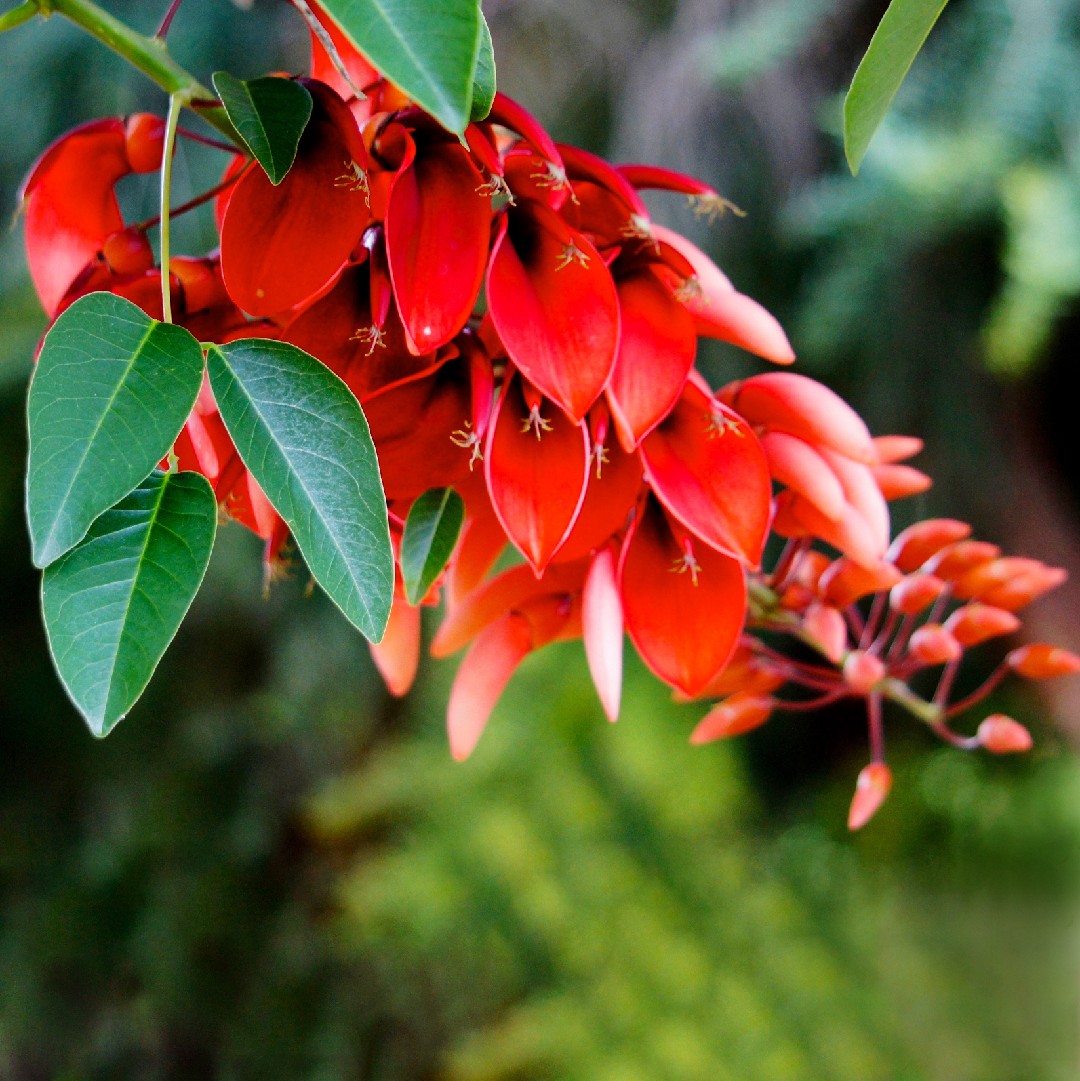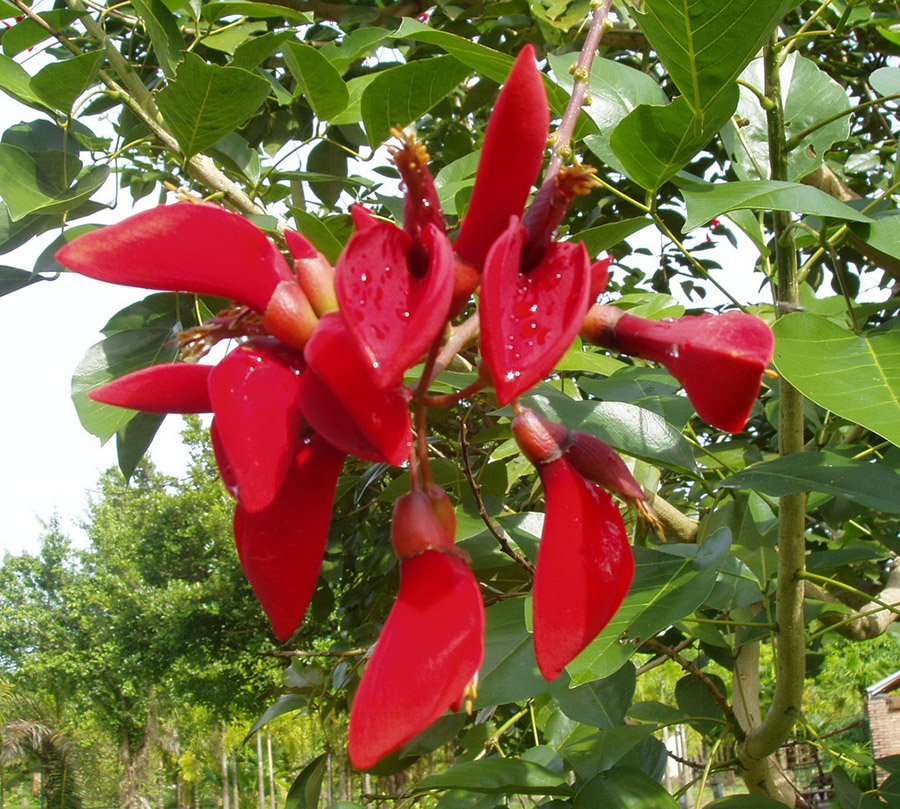Nestled between Argentina and Brazil, Uruguay is a progressive and prosperous nation known for its vibrant culture, passionate love of football, and scenic beaches. Among its many symbols, Uruguay takes great pride in its national flower, the exquisite Ceibo Erythrina (Erythrina crista-galli), which it shares with Argentina. Join us as we explore this vibrant scarlet bloom, a flower as deeply rooted in Uruguayan culture as its famous mate tea.
Description of the Ceibo Erythrina
Belonging to the Fabaceae (Legume) family, the Erythrina crista-galli, commonly known as the Ceibo or Cockspur Coral Tree, is a stunning sight. This deciduous tree grows between 5 to 8 meters tall, with a distinctive umbrella-shaped crown and a thorny, gnarled trunk.
The real charm of the Ceibo lies in its striking blooms. Flowering from October to April, the vibrant red blossoms are shaped like a rooster’s comb, inspiring the scientific name ‘crista-galli,’ meaning ‘cock’s comb’ in Latin. The flowers are arranged in beautiful inflorescences, forming cascades of scarlet that capture the eye and heart.
The Ceibo’s leaves are equally remarkable—bright green, glossy, and trifoliate (divided into three leaflets), providing a lush contrast to the bright red flowers. After the flowering season, the tree produces woody black pods filled with large, shiny seeds.

Habitat of the Ceibo Erythrina
Native to South America, the Ceibo Erythrina thrives in the subtropical and temperate regions of Uruguay, northern Argentina, Paraguay, and Brazil. It is commonly found near rivers, streams, and wetlands due to its preference for humid soils and climates.
In Uruguay, the Ceibo’s vibrant blooms brighten both rural landscapes and urban parks and streets. The tree’s resilience to poor soil conditions, pollution, and flooding makes it a popular choice for urban landscaping.
The Ceibo Erythrina in the Ecosystem
Ceibo trees play several important ecological roles. Their nectar-rich flowers provide food for birds, bees, and butterflies, aiding the tree’s pollination. Notably, the vibrant flowers attract the Ruby Topaz Hummingbird (Chrysolampis mosquitus), a dazzling bird with a fiery red throat and brilliant golden back.
The tree’s dense crown also offers shelter for various bird species, creating safe nesting sites. Ceibo seeds are a food source for certain rodents, and the tree’s roots help stabilize soil, preventing erosion, especially along riverbanks and wetlands.
Additionally, the Ceibo serves as a host plant for various Lepidoptera (butterflies and moths), highlighting its ecological significance. Overall, the Ceibo contributes greatly to the biodiversity of its native regions.

Symbolism and Meaning: Why and When Did the Ceibo Erythrina Become Uruguay’s National Flower?
The Ceibo Erythrina was declared the national flower of Uruguay in 1948, and its vibrant crimson flowers have since become a symbol of pride and national identity for Uruguayans. The tree holds profound cultural significance, with roots in native Guarani legends.
According to one popular myth, the Ceibo tree is the reincarnation of a beautiful maiden named Anahí, who was transformed into a tree with bright red flowers after being burned at the stake. Her story of courage, love, and sacrifice has made the Ceibo a powerful symbol of strength, passion, and resilience in the face of adversity.
The Ceibo’s ability to thrive in a variety of conditions, including poor soils and flood-prone areas, also reflects the resilience and perseverance of the Uruguayan people, reinforcing its symbolism in the national consciousness.
Names of the Ceibo Erythrina
The Ceibo Erythrina is known by various names. Its scientific name, Erythrina crista-galli, is derived from the Greek words ‘erythros’ meaning ‘red’ and ‘rhinos’ meaning ‘nose’, perfectly describing its distinctive crimson flowers. The term ‘crista-galli’ is Latin for ‘cock’s comb’, referring to the flower’s unique shape.
Commonly referred to as ‘Ceibo’ in Uruguay and Argentina, it is known as ‘Corticeira’ in Brazil. In English-speaking regions, the tree is called the ‘Cockspur Coral Tree’ or ‘Cry-Baby Tree’. These varied names reflect the widespread appreciation of this remarkable tree across different cultures and countries.

Interesting Facts About the Ceibo Erythrina
While the Ceibo is primarily admired for its striking appearance, it also serves several practical purposes:
- The tree’s lightweight but strong wood is traditionally used by native tribes to craft canoes.
- It is a favorite among bird species such as orioles and blackbirds, which nest in its branches, attracted by the bright red flowers and the protection offered by its thorny trunk.
- The Ceibo is not only cherished in Uruguay; Argentina also recognizes the red flower of this tree as its national flower.
- The bark of the Ceibo has been used in traditional medicine for its supposed sedative and antispasmodic properties.
- Every November, the town of Bella Unión in Uruguay celebrates the “Fiesta del Ceibo,” where streets are adorned with the tree’s bright red flowers, and the community participates in parades, dances, and other cultural festivities.

How to Grow the Ceibo Erythrina
The Ceibo Erythrina is a resilient tree that can adapt to various conditions. To cultivate a healthy and vibrant Ceibo, consider the following tips:
- Soil: The tree prefers well-draining soil and can thrive in a variety of soil types, including clay, sand, and loam.
- Sunlight: Ceibo requires full sunlight for optimal growth. While it can tolerate some partial shade, insufficient sunlight may lead to sparse flowering.
- Water: Though drought-tolerant, the tree thrives best with regular watering. Avoid waterlogging, as this can harm the roots.
- Temperature and Humidity: Native to South America, the Ceibo thrives in warm temperatures and high humidity. It is not frost-tolerant, so in colder climates, winter protection may be necessary.
- Planting: Propagation is commonly done through seeds. Soak the seeds for a day before planting to encourage germination.
- Maintenance: Regular pruning helps maintain the tree’s shape and encourages more branching, leading to increased flowering. Be mindful of the tree’s spines when pruning.

Other Beautiful Flowers Native to Uruguay
In addition to the Ceibo, Uruguay is home to a diverse array of flowers that enhance the country’s natural beauty.
- Monte Yellow Snapdragon (Galvezia speciosa): This beautiful shrub features tube-like flowers in a vibrant shade of yellow. The Monte Yellow Snapdragon is a hardy plant that adapts well to various soils and climates.
- Uruguayan Firecracker Plant (Dicliptera squarrosa): Known for its brilliant red flowers that bloom in clusters, this plant attracts hummingbirds and butterflies, making it a charming addition to any landscape.
- Butia capitata: Commonly referred to as the Jelly Palm, this plant produces fragrant yellow flowers that develop into edible fruit. It serves both ornamental and culinary purposes.
- Chamissoa altissima: A tropical vine with delicate white flowers, this plant is also known as climbing bamboo and adds a graceful touch to its surroundings.
Final Thoughts
With its brilliant crimson blossoms, the Ceibo truly embodies the passionate spirit of Uruguay. This resilient tree symbolizes strength and survival, thriving in various conditions and providing shelter and sustenance to numerous species.
Its stunning flowers bring a fiery splash of color to the Uruguayan landscape, making it a true visual marvel. Uruguayans take immense pride in this national symbol that represents their rich culture and history.
